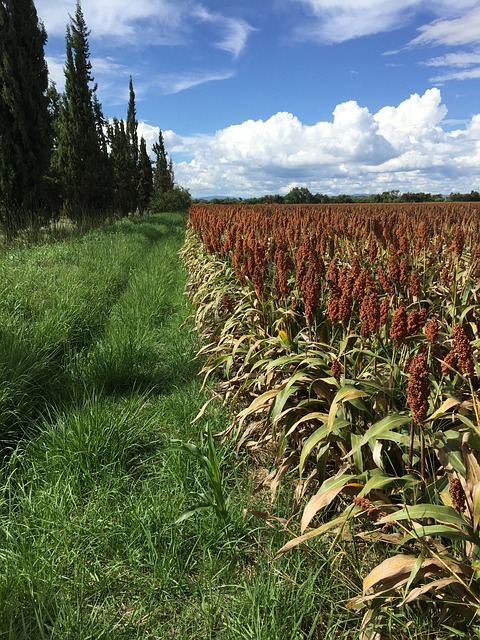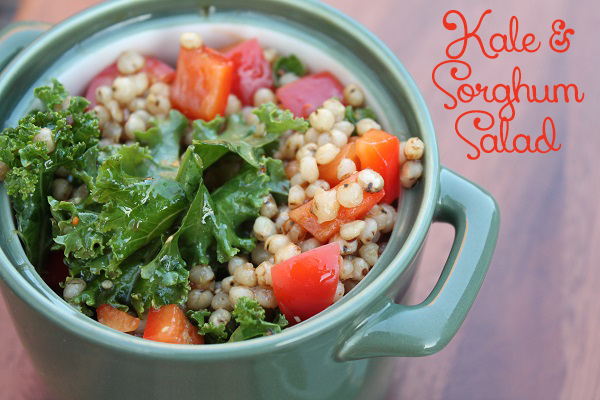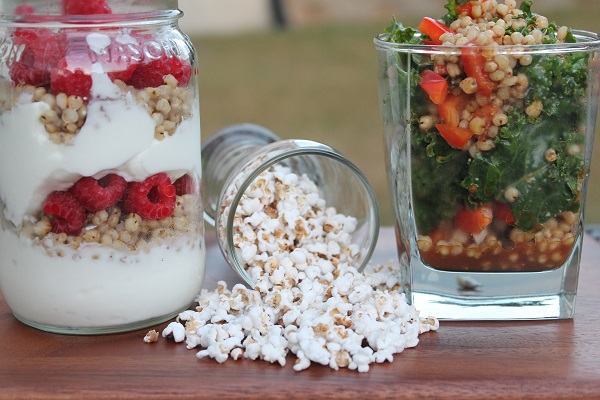Unless you live in the Sorghum Belt (and yes, that really exists!), you likely have no clue what sorghum is or what to do with it. However, it’s the 5th most important cereal crop in the world due to its natural drought tolerance and versatility as feed, fuel and food. So why haven’t we heard more about it?
History of Sorghum
Sorghum is an ancient cereal grain that originated around 8,000 B.C. in Southern Egypt. It then spread throughout Africa, the Middle East and Asia via ancient trade routes. Sorghum was introduced to America in 1757 by Benjamin Franklin who first used the broomcorn variety to make, you guessed it, brooms!
Fast forward a couple hundred years, and the United States is now the world’s largest producer of grain sorghum, having produced 597 million bushels in 20151. Sorghum is primarily planted and harvested on dryland acres from South Dakota to Southern Texas, coined the “Sorghum Belt.”
5 Fun Facts about Sorghum
- In Africa, leather is sometimes dyed red with the help of red varieties of sorghum.
- Some of the starches used for adhesives and paper are derived from sorghum.
- Maotai, a Chinese liquor served at state banquets, is distilled from fermented sorghum.
- There’s an Annual Sorghum Festival in Sampson County, NC on the third Saturday in October.
- You can pop sorghum! It’s just like popcorn but smaller (see recipe below).
Types of Sorghum
Sorghum comes in many different shapes, sizes and colors, each with unique applications. Red, orange and bronze sorghum are the most common and are used in all areas of the sorghum industry. Tan, cream and white varieties are generally used to make flour, while black and burgundy sorghum are used in the food industry thanks to their beneficial antioxidant properties.
In the US, three main types of sorghum are grown- grain, sweet and forage.
- Grain Sorghum grows about 5 feet tall and is used for feed, fuel and food.
- Sweet Sorghum is harvested for its stalks rather than the grain. The stalks are pressed and the juice is used to produce a syrup. Sorghum syrup can be used as a sweetener or fermented and distilled to produce biofuels.
- Forage Sorghum grows 6-12 feet tall and produces more dry matter compared to grain sorghum. Due to its coarse stem, this type of sorghum is primarily used for silage (animal feed in the winter).
Uses of Sorghum

According to Jack Harlan in 1971, “sorghum is one of the really indispensable crops” required for the survival of humankind. Outside of its main uses as feed, fuel and food, sorghum is also used to create building materials, fences, floral arrangements, brooms and much more.
Feed
Approximately 46% of US sorghum is used as feed for poultry, beef, dairy and swine. The stems and foliage are also used for hay, silage and pasture. Learn more about sorghum’s role in the livestock industry.
Fuel
Sorghum is a high-energy, drought tolerant, environmentally friendly crop. Nearly one-third of the US sorghum is used for renewable fuel production. Compared to feedstock, sorghum produces the same amount of ethanol per bushel (2.7 gallons) while using up to one-third less water.
In short, sorghum naturally does more with less! To learn more about sorghum as a renewable fuel, check out this short video and article.
#Sorghum produces the same amount of ethanol as feedstock but with one-third less water #renewables Click To TweetFood
Since sorghum is primarily used in the US as feed and fuel, it’s easy to see why so many of us have never heard of or tried sorghum in a culinary application. However, consumer demand for sorghum is on the rise and there are now more than 350 food products available.
Sorghum is a gluten-free whole grain with a hearty, chewy texture that’s perfect for pilafs, cold salads and yogurt parfaits. Used as the grain itself or as a flour, it can creatively be incorporated into dishes for breakfast, lunch, dinner or even snacks (you can pop it just like popcorn!).
Sources:
1. Sorghum Checkoff, 2. Sorghum Growers, 3. Whole Grains Council, 4. Bob’s Red Mill
Cooking with Sorghum
Basic Cooking Instructions (makes 4 servings, about 2 ½ cups cooked):
- Rinse 1 cup sorghum.
- Place in a medium-sized pot with 3 cups water or stock.
- Bring to a boil, cover, reduce heat and simmer until tender, 50-60 minutes.
- Drain excess liquid.
Using these basic cooking instructions, start experimenting with adding sorghum to some of your go-to whole grain recipes. As a time-saver, make a large batch and store cooked sorghum in the freezer to use later.
Check out these 3 ways to use sorghum any time of day (recipes below):
- Breakfast: Berry Sorghum Parfait
- Lunch or Dinner: Kale and Sorghum Salad
- Snack: Popped Sorghum
Berry Sorghum Parfait
Serves 1
PRINT RECIPE

Ingredients
⅓ cup cooked sorghum
6-8 ounces plain Greek yogurt
½ cup berries of choice, fresh or frozen
Honey, to taste (optional)
Directions
- Place half of the yogurt in the bottom of a bowl or glass jar.
- Add half of the cooked sorghum and drizzle with honey for added sweetness, if desired (tastes great without it though!).
- Top with half of the berries.
- Repeat layers with remaining ingredients, finishing with berries on top.
- Serve immediately or store in the fridge up to 1 day.
Time Saving Tips
- Prepare a large batch of sorghum and store in the fridge to use throughout the week or in the freezer for later use. Reheat slightly to loosen the grains and then, once cooled, assemble parfait according to directions.
- Prepare parfait the night before and store in the fridge for a quick, easy breakfast the next morning.
Kale and Sorghum Salad
Serves 2
Recipe Adapted From: wondergrain.com
PRINT RECIPE

Ingredients
For the salad:
2 cups kale, finely chopped
½ cup red bell pepper, diced
1 cup cooked sorghum
¼ of a sweet onion, thinly sliced (optional)
For the dressing:
2 Tbsp olive oil
1-2 Tbsp balsamic or red wine vinegar
1 Tbsp Dijon mustard
1 clove garlic (or more to taste), minced
Juice of ½ lime
1 tsp honey (or more to taste if too acidic)
Salt and pepper, to taste
Directions
- Remove stems from kale and cut lengthwise. Roll up several leaves like a cigar for easier chopping and cut into small pieces.
- Dice peppers into small pieces and thinly slice onion (if using).
- Combine finely chopped kale, diced peppers, cooked sorghum and onion (if using).
- Whisk together dressing ingredients, adjusting salt, pepper and honey to taste.
- Pour dressing over salad and toss well.
- Serve immediately or store in the fridge. This recipe does well leftover and is just as good, if not better, the next day. The kale will not wilt and the sorghum will not be soggy!
Make it a Meal: top with cooked protein of choice.
Notes
- If serving immediately, you can marinate the kale (and onion, if using) in the dressing mixture for 1-2 hours before making the salad to help soften it and remove some of the bitterness.
- If using precooked sorghum, warm it up first to loosen it up a bit. Let cool and then prepare salad.
Popped Sorghum
Serves 2
PRINT RECIPE

Ingredients
¼ cup sorghum, dry
Seasonings of choice (salt, pepper, cumin, chili powder, cinnamon, etc)
Directions
Stove Top Method
- Heat a stainless steel pot with a tight fitting lid over medium-high heat.
- Add sorghum once hot and cover with lid.
- Cook, shaking pot often, until sorghum begins to pop.
- Remove from heat when there are more than 10 seconds between pops.
- Season as desired.
Microwave Method
- Place sorghum in a brown paper lunch bag.
- Fold top down several times to close.
- Place folded side down in microwave and heat on high for 2-3 minutes (time will vary depending on microwave).
- Remove from microwave when there are more than 10 seconds between pops.
- Season as desired.
Make it a Snack: for an anchored, well-balanced snack, sprinkle in or pair with nuts, seeds, cheese or other protein or healthy fat of choice.
Notes: check out THIS BLOG for DIY popcorn seasoning ideas. Recipes included!
What's your favorite sorghum recipe?
Click here for a printer-friendly version of this blog post.





1 Comment
i am so happy to see this in the Sugar Challenge. i make Jowar roti out of whilte Jowar flour and it's very good - to make Jowar flour roti
https://www.vegrecipesofindia.com/jowar-roti-recipe-jowar-bhakri/#wprm-recipe-container-136700